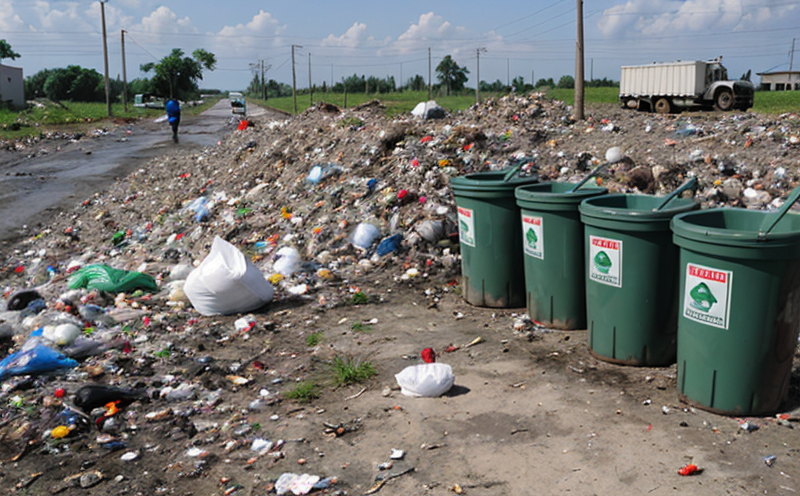EN 16192 Characterization of Solid Waste Leachates Test
The EN 16192 standard provides a comprehensive approach to characterizing the leachate from solid waste. Leachate refers to the liquid that percolates through solid waste and contains dissolved materials derived from its decomposition process. This test is essential for ensuring environmental compliance, assessing potential risks associated with landfills, and supporting informed decisions in waste management.
The standard specifies methods for determining the chemical composition of leachate, which helps in understanding the impact of waste on the environment. Compliance with EN 16192 is critical for facilities managing hazardous or non-hazardous solid waste to ensure that they meet regulatory requirements set by environmental protection agencies.
The test involves several steps aimed at accurately characterizing leachate, including sample preparation and analysis of various parameters. Sample preparation typically includes collecting the leachate from a controlled environment such as a landfill or waste storage facility. The collected samples are then analyzed for their chemical composition using advanced analytical techniques.
Key parameters measured include pH, conductivity, metal ions (such as copper, lead, and zinc), organic compounds like BOD5 and COD, and microbial indicators. These measurements provide valuable insights into the potential environmental impact of leachate discharge to soil or water bodies.
The results from EN 16192 help in assessing whether the waste management practices are environmentally sound. They also assist in identifying areas for improvement, ensuring that any changes made align with both regulatory standards and sustainability goals. Compliance testing ensures that facilities operate within legal boundaries while minimizing their ecological footprint.
Understanding leachate characteristics allows stakeholders to implement effective mitigation strategies if necessary. For instance, if high levels of certain contaminants are detected, this information can guide the development of treatment processes aimed at reducing harmful effects on ecosystems and human health.
To summarize, EN 16192 plays a crucial role in safeguarding environmental integrity by providing detailed information about leachate composition. It supports informed decision-making regarding waste management practices, promotes sustainable operations, and contributes to overall compliance with international standards.
Why It Matters
The importance of the EN 16192 Characterization of Solid Waste Leachates Test cannot be overstated. Proper characterization ensures that waste management practices are environmentally responsible, thereby protecting public health and the environment from potential harm caused by improperly managed solid waste.
- Regulatory Compliance: Adherence to this standard is mandatory for many industries dealing with hazardous or non-hazardous solid waste. Failure to comply can result in significant penalties and reputational damage.
- Ecosystem Protection: By accurately characterizing leachate, we gain a better understanding of its composition and potential impacts on local ecosystems. This knowledge enables proactive measures against pollution.
- Sustainable Operations: Compliance with EN 16192 helps facilities operate sustainably by identifying opportunities for improvement in waste management processes.
In summary, the characterization of solid waste leachates is vital for maintaining environmental quality and ensuring that industrial activities do not adversely affect the natural environment. It fosters a culture of responsible stewardship towards our planet's resources.
Quality and Reliability Assurance
- Standard Operating Procedures: Strict adherence to predefined procedures ensures consistent results across different laboratories performing the EN 16192 test. Consistency is crucial for reliable data interpretation.
- Calibration of Instruments: Regular calibration of analytical instruments guarantees accurate measurements, which are essential for precise characterization of leachates.
- Data Validation: Independent validation of results through additional testing methods enhances confidence in the accuracy and reliability of reported findings.
The implementation of these measures ensures that every aspect of the EN 16192 Characterization of Solid Waste Leachates Test is conducted under controlled conditions, leading to trustworthy outcomes. This commitment to quality control strengthens trust between clients and service providers alike.
Environmental and Sustainability Contributions
- Pollution Prevention: By identifying pollutants in leachate, the EN 16192 test aids in preventing their release into the environment. This proactive approach supports sustainable waste management practices.
- Eco-friendly Solutions: Understanding leachate composition allows for the exploration of eco-friendly solutions tailored to specific waste types, promoting green technologies and practices.
The EN 16192 Characterization of Solid Waste Leachates Test contributes significantly to environmental protection efforts. It encourages continuous improvement in waste management strategies, ultimately fostering a more sustainable future for all.





